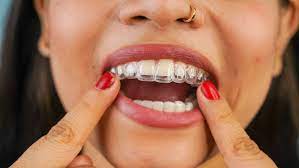When it comes to straightening teeth, many patients find themselves asking, Invisalign vs braces, which is right for you? Both orthodontic treatments offer effective solutions for aligning teeth, correcting bites, and improving smiles. However, choosing between them depends on factors like comfort, appearance, cost, and the complexity of your dental issues. Understanding the differences between Invisalign Aligners and braces can help you make the best decision for your oral health and lifestyle.
Appearance and Aesthetic Preferences:
One of the most noticeable differences between Invisalign and braces is their visibility. Many patients, especially adults and teens, prefer a treatment that is discreet and less noticeable.
- Invisalign: Clear, plastic aligners that are virtually invisible
- Traditional Braces: Metal brackets and wires attached to teeth
- Ceramic Braces: Tooth-colored brackets for a more subtle look
- Lingual Braces: Hidden behind the teeth, but less common and more costly
If aesthetics are a major concern, Invisalign is often the preferred choice due to its clear and removable design.
Comfort and Daily Experience:
Another important consideration is how each treatment feels on a day-to-day basis. While both move your teeth gradually, they affect your comfort differently.
- Invisalign: Smooth plastic trays reduce the chance of irritation
- Braces: Brackets and wires may cause soreness or mouth abrasions
- Removability: Invisalign can be taken out while eating and brushing
- Eating Restrictions: Braces require avoiding hard, sticky, or chewy foods
Invisalign aligners are known for being more comfortable overall, but they require discipline to wear them 20–22 hours per day.
Effectiveness for Complex Dental Issues:
Not all cases are the same. The severity of your dental condition can influence whether Invisalign or braces are more effective for treatment.
- Braces: Better suited for severe crowding, major bite issues, and complex shifts
- Invisalign: Ideal for mild to moderate misalignment and spacing issues
- Treatment Planning: Both options use detailed imaging and mapping
- Consistency: Braces work continuously; Invisalign only works when worn properly
For more complex orthodontic corrections, your dentist may recommend traditional braces over Invisalign.
Maintenance and Oral Hygiene:
Keeping your mouth clean during treatment is essential to prevent decay and gum problems. Aligners in Dubai and braces differ in how easy they make oral hygiene.
- Invisalign: Easily removable, allowing normal brushing and flossing
- Braces: Require special tools to clean around wires and brackets
- Risk of Plaque Buildup: Higher with braces if not cleaned thoroughly
- Aligner Cleaning: Invisalign trays need to be rinsed and brushed regularly
If maintaining oral hygiene is a top priority, Invisalign often provides a simpler and more effective solution.
Cost and Insurance Coverage:
Cost is often a deciding factor in the choice between Invisalign and braces. Prices can vary depending on the treatment duration and dental provider.
- Insurance Coverage: Many plans cover both options, but with different limits
- Financing Options: Most orthodontic clinics offer payment plans
Although Invisalign may be slightly more expensive, the convenience and aesthetic benefits often justify the cost for many patients.
Lifestyle and Personal Preference:
Ultimately, the decision may come down to which option fits better with your lifestyle, habits, and willingness to comply with treatment requirements.
- Self-Discipline: Invisalign requires consistent wear and responsibility
- Active Lifestyle: Braces may be more durable for sports and physical activity
- Speech Changes: Both can affect speech slightly in the beginning
- Travel and Routine: Invisalign users need to carry their case and plan for cleanings
Choosing between Invisalign and braces depends on your daily routines, motivation, and how important convenience and appearance are to you.





Comments